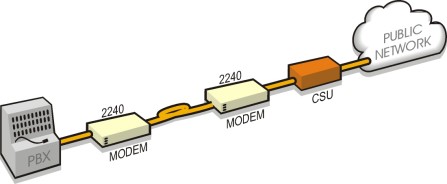Features for
Canoga Perkins 2240 fiber optic modems
- G.703 Compatible E1/T1 Interfaces
- Internal/external/slave clock modes
- Front panel switch-selectable speeds from DC (0bps) to 2.048Mbps
- System Diagnostics
- Local/remote Loopback
- Interchangeable Interfaces
- Pass-through controls
- Single/multimode optics
- 850nm, 1310nm and 1550nm
- Power/Modem Redundancy (optional) in Rack Assembly
- Stand alone/Rack mount
- 120VAC, 240VAC and -48 VDC
Description
Offering more than more than 15 field interchangeable
interfaces, the 2240 is an unusually versatile Async/Sync/T1/E1 Fiber
Optic Modem.
The Canoga Perkins 2240 fiber modem operates asynchronously at speeds from DC (0bps) to 1.024Mbps
and synchronously between DC and 2.1Mbps. Operating modes and internal
clock rates are controlled by an eight-position DIP switch located on
the front panel. The 2240 has a built-in clock synthesizer which
generates dozens of common clock rates and allows for optional
custom-selected oscillators to generate special clock rates.
As a versatile modem, the Canoga Perkins 2240 fiber modem provides multiple secondary data channels
that can be used for alarms and interface handshaking control signals.
To better fit a specific application, the Canoga Perkins 2240 fiber
modem is available in either
standard or long distance versions. Standard versions are 850nm or
1300nm.Long distance versions are 1310nm high power laser and 1550nm
extended distance laser.
For applications that require multiple modems, the 2201 Rack Assembly
holds up to ten 2200 Series Modems. Standard features of the 2201
include audio, visual and dry contact alarms in the event of power
supply failure. Redundant power is also available as an optional
feature.
Typical
Application for the Canoga Perkins 2240 fiber modem


|